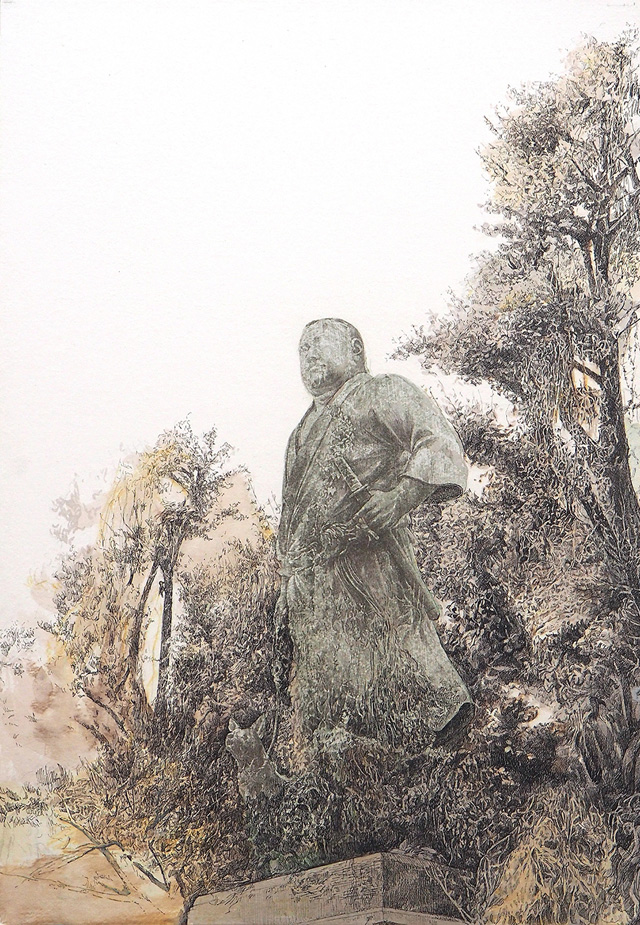
From November 24 (Sat.) to December 23 (Sun.), 2018, Gallery KIDO Press is holding an exhibition titled "Monuments" by Hisaharu Motoda. This will be the first exhibition of hand-drawn/painted pictures (with collages) by Motoda, an artist who has come to the fore in the field of contemporary prints. Centering around six pictures newly created for it, including a large work about two meters wide, this exhibition will also display two recent prints on the same theme, for a total of eight.
Born in Japan's Kumamoto Prefecture in 1973, Motoda has had a fondness for antiquated shrines, old brick walls streaked with cracks, and similar things since childhood, and has used the same as motifs in his works. After graduating with a bachelor's degree in art from Kyushu Sangyo University in 1999, he moved to Tokyo, where he completed studies in the master's program in painting (specializing in printing) in the Tokyo National University of Fine Arts and Music (the current Tokyo University of the Arts) Graduate School in 2001. Interested in the process whereby man-made structures exposed to the elements gradually weather and approach nature, he likewise retained the impression of fictionality imbuing the urban landscape which he initially received from the streets of Tokyo after moving there from the country. Drawing on these elements, he has been vividly portraying the decaying figures of existing landmarks with a meticulous touch since 2004.
Among the different types of printing techniques, Motoda has thus far turned to lithography to transform sights everyone knows into visions of cities going to ruin. To him, drawings made by hand can be printed with lithography as they are, while the passage through the press seems to distance the resulting print from the artist. He therefore became convinced that lithography was a means of "dry" expression not leaving any raw traces of the artist's hands. The scenery depicted with such objectivity simultaneously appears to be an unknown collective memory. How did the buildings become ruins? What happened there? Mixing the past, present, and future as they entice us into a cosmos of space and time with a certain reality of its own, Motoda's printed works have intrigued many viewers.
"Foresight: Statue of Saigo Takamori"
For this exhibition, Motoda set out to present the process of weathering whereby objects made by human hands gradually approach nature in the form of pictures as opposed to prints. In these works, only the statue parts have been printed by lithography on silver or aluminum leaf pasted on the paper in advance. The artist then made collages with statue-form cut-outs, and drew or painted on them for careful depiction of the slow proliferation of plants over time. For example, in the new picture "Foresight: Statue of Saigo Takamori 1," he first laid down the image of the statue on leaf by printing, and then used water colors to paint the background and the plants that look as if they are proliferating over the statue. Unlike the monochromatic world of his past prints, these pictures are deftly tinted.
The resulting scene could be termed a lovely one woven by the contrast between the artificial object depicted through lithography and natural features drawn directly by hand. It may also be regarded as the landscape that will arise when a mere statue evolves into a monument accompanied by collective memory along with the passage of time.
Motoda commented that, while he constantly thought about the degree of weathering on buildings in making his previous prints, the vines of ivy growing over public sculptures in these pictures also make for expression contrasting with the former. This is to say that weathering is not simply a process of decay but also the start of a revival. In it, we can sense and foresee future rebirth and breathing.
Motoda has routinely been producing prints for the approximately 20 years since he encountered the lithography technique of printed expression. Please be sure to see the new universe that opened up when he turned his attention to pictures.
当サイトには、入居している各団体が行う催事についての情報も掲載されています。
展覧会やイベントなどに関するお問い合わせは、各団体へお願い致します。